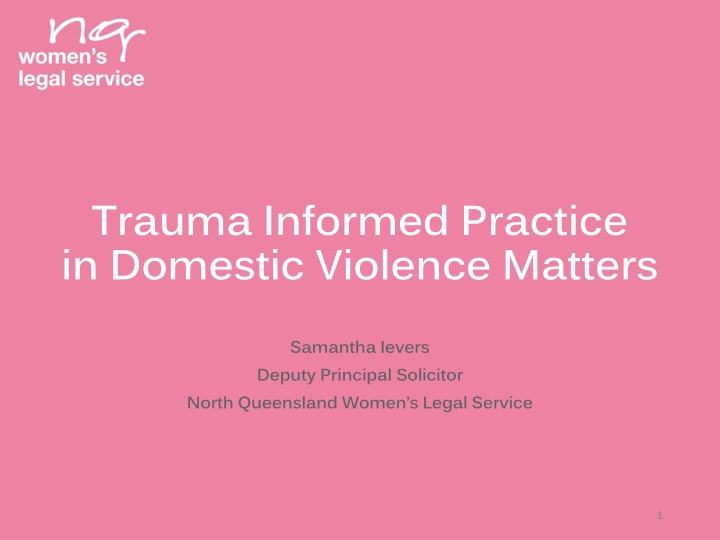
Understanding Trauma and Trauma-Informed Practice in Domestic Violence
Explore the concept of trauma and its potential symptoms as well as the importance of trauma-informed practice in domestic violence matters, with insights from professionals and available resources. Learn how trauma can impact individuals differently and the significance of being attuned to all aspects of service delivery for effective support.
Download Presentation

Please find below an Image/Link to download the presentation.
The content on the website is provided AS IS for your information and personal use only. It may not be sold, licensed, or shared on other websites without obtaining consent from the author. If you encounter any issues during the download, it is possible that the publisher has removed the file from their server.
You are allowed to download the files provided on this website for personal or commercial use, subject to the condition that they are used lawfully. All files are the property of their respective owners.
The content on the website is provided AS IS for your information and personal use only. It may not be sold, licensed, or shared on other websites without obtaining consent from the author.
E N D
Presentation Transcript
Trauma Informed Practice in Domestic Violence Matters Samantha Ievers Deputy Principal Solicitor North Queensland Women s Legal Service 1
What is trauma? The Australian Psychological Society swebsite contains useful information about what trauma is and the potential symptoms. https://psychology.org.au/for-the-public/psychology-topics/trauma Very frightening or distressing events may result in a psychological wound or injury. This trauma can result in difficult in coping or functioning normally. Everyone s reaction to potentially traumatic experiences is different. Some people experience problems directly after the traumatic event or much later. Potentially traumatic events are powerful and upsetting incidents that intrude into daily life. They are usually experiences which are life threatening or pose a significant threat to a person s physical or psychological wellbeing. An event may have little impact on one person but cause severe distress in another.
Potential symptoms of trauma Taken from the Australian Psychological Society swebsite: https://psychology.org.au/for-the-public/psychology-topics/trauma Most people have strong emotional or physical reactions following experience of a traumatic event. For most, these reactions subside over a few days or weeks. For some, the symptoms may last longer and be more severe. This may be due to several factors such as the nature of the traumatic event, the level of available support, previous and current life stress, personality, and coping resources.
Potential symptoms of trauma (Continued) Taken from the Australian Psychological Society swebsite: https://psychology.org.au/for-the-public/psychology-topics/trauma Physical symptoms can include excessive alertness (always on the look-out for signs of danger), being easily startled, fatigue/exhaustion, disturbed sleep and general aches and pains. Cognitive (thinking) symptoms can include intrusive thoughts and memories of the event, visual images of the event, nightmares, poor concentration and memory, disorientation and confusion. Behavioral symptoms can include avoidance of places or activities that are reminders of the event, social withdrawal and isolation and loss of interest in normal activities. Emotional symptoms can include fear, numbness and detachment, depression, guilt, anger and irritability, anxiety and panic.
What is trauma informed practice? Blue Knot Foundation for resources, information and training https://professionals.blueknot.org.au/professional-development-training/training-for-individuals/ Dr Cathy Kezelman AM and Dr Pam Stavropoulos, President and Head of Research - Blue Knot Foundation (2016) Trauma and the Law: Applying Trauma-Informed Practice to Legal and Judicial Contexts (2016), page 6: Becoming trauma-informed means being attuned to all aspects of a service and how it is delivered (i.e. formal and informal; from policy and procedure, to first contact interactions and the manner in which clients are engaged.
What is trauma informed practice? (Continued) Dr Cathy Kezelman AM and Dr Pam Stavropoulos, President and Head of Research - Blue Knot Foundation (2016) Trauma and the Law: Applying Trauma-Informed Practice to Legal and Judicial Contexts (2016), pages 5, 6: Core principles of trauma-informed practice 1. Basic knowledge of the impacts of stress on the brain and body 2. Consistent emphasis on safety, trustworthiness, choice, collaboration and empowerment (emphasis on doing with rather than for or to) 3. Consistent emphasis on the way in which a service is provided (i.e. the how as much as the what ; the context in which services are delivered, not just what the service is) 4. Consistent emphasis on what may have happened to a client, rather than what is wrong with client/s
What is trauma informed practice? (Continued) Dr Cathy Kezelman AM and Dr Pam Stavropoulos, President and Head of Research - Blue Knot Foundation (2016) Trauma and the Law: Applying Trauma-Informed Practice to Legal and Judicial Contexts (2016), pages 5, 6: Core principles of trauma-informed practice (continued) 5. Recognition that difficult behaviour and/or symptoms may be the product of coping mechanisms and attempted self-protection in light of prior adverse experiences. If not seen through the lens of trauma, client behaviour is often and inappropriately labelled as pathological, when [it] should instead be viewed as adaptations a person has had to make in order to copy with life scircumstances (citing Melanie Randall & Lori Haskell, Trauma-Informed Approaches to Law: Why Restorative Justice Must Understand Trauma and Psychological Coping , The Dalhousie Law Journal (Fall 2013), p. 508) 5. A strengths-based approach which acknowledges people s skills, notwithstanding the enormity experiences with which they may be struggling and effects of overwhelming (citing Melanie Randall & Lori Haskell, Trauma-Informed Approaches to Law: Why Restorative Justice Must Understand Trauma and Psychological Coping , The Dalhousie Law Journal (Fall 2013), p. 509)
Impact of trauma & DFV on clients Remember everyone will respond differently to trauma and FDV. We must consider howwe provide advice and howwe assist clients, not merely what our advice will be and what our legal strategy will be. Clients who have been affected by trauma and DFV are not difficult viewing clients in this manner places responsibility on them for what has happened to them.
Impact of trauma & DFV on clients (Continued) Clients affected by trauma and FDV may: Be emotional, angry, physically shaking. Find it challenging to provide instructions. Not disclose an event/s or incident/s. Present as withdrawn or uninterested, or struggle to focus. Find decision-making difficult. Be overwhelmed and find it challenging to absorb information. Speak in a matter-of-fact manner. Be suspicious. Justify, excuse and/or minimise the traumatic event/s or DFV, or even take on responsibility.
Supporting clients Special Taskforce on Domestic and Family Violence in Queensland, Not Now, Not Ever: Putting an End to Domestic and Family Violence in Queensland (2015): https://www.publications.qld.gov.au/dataset/not-now-not-ever/resource/533db62b-b2c9-43cc- a5ff-f9e1bc95c7c7 Alarmingly, the Taskforce heard many stories where the workings of the law and justice system (police and courts) only serve to further victimize or marginalise victims. Thevulnerability of victims and survivors of domestic and family violence needs to be placed at the forefront. victims need to be better supported through the complex legal system The Taskforce believes that those dealing with domestic and family violence cases must fully understand and be responsive to the complex nature of such cases. The vulnerability of victims of domestic violence needs to be accounted for and the law needs to be more accessible.
Supporting clients (Continued) Education about trauma and domestic & family violence + trauma-informed practice. Don t make assumptions about what act of DFV is most triggering or has had the most impact on a client. Use plain English and test understanding. Encourage questions and discussion. Follow-up in writing. Provide a written list of nextsteps . Focus on the client & look for non-verbal cues that they are anxious, struggling with the conversation or not understanding. Pause for a break. Prioritise the client s wellbeing. Encourage the use of support people. Explain why questions are asked or information is required. Building a trusting relationship takes time, as does decision-making. Explain what to expect at court beyond merely the outcome. Acknowledge the DFV or trauma. Remove responsibility from the victim.
Questions? 12






















